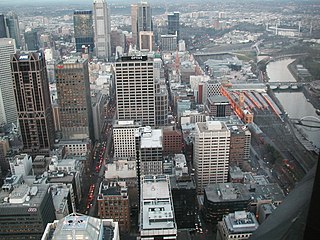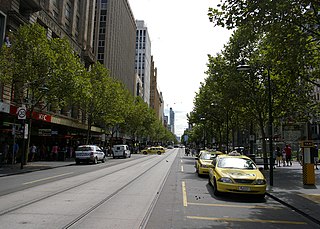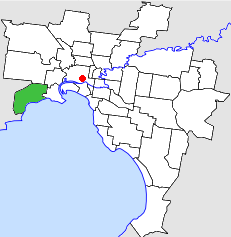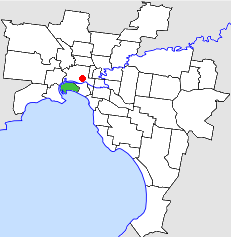
Hoddle Grid is the contemporary name given to the approximately 1-by-0.5-mile grid of streets that form the Melbourne central business district, Australia. Bounded by Flinders Street, Spring Street, La Trobe Street, and Spencer Street, it lies at an angle to the rest of the Melbourne suburban grid, and so is easily recognisable. It is named after the surveyor Robert Hoddle, who marked it out in 1837, establishing the first formal town plan. This grid of streets, laid out when there were only a few hundred settlers, became the nucleus for what is now Melbourne, a city of over five million people.

Moomba is held annually in Melbourne, Australia. Run by the City of Melbourne, it is Australia's largest free community festival. The Melburnian tradition is celebrated over four days, incorporating the Labour Day long weekend, from Friday to the second Monday in March. Moomba is culturally important to Melbourne, having been celebrated since 1955, and regularly attracts up to a million people, with a record attendance of 3.8 million set in 2018.

Swanston Street is a major thoroughfare in the Melbourne central business district, Victoria, Australia. It was laid out in 1837 as part of the original Hoddle Grid. The street vertically bisects Melbourne's city centre and is famous as the world's busiest tram corridor, for its heritage buildings and as a shopping strip.

La Trobe Street is a major street and thoroughfare in the Melbourne central business district, Victoria, Australia. It runs roughly east–west and forms the northern boundary of the central business district. The street was laid out as an extension of the original Hoddle Grid in 1839 and was named after Charles La Trobe. La Trobe Street extends from Victoria Street in the east to Harbour Esplanade in the west.

Yarra Park is part of the Melbourne Sports and Entertainment Precinct, the premier sporting precinct of Victoria, Australia. Located in Yarra Park is the Melbourne Cricket Ground (MCG) and numerous sporting fields and ovals, including the associated sporting complexes of Melbourne and Olympic Parks. The park and sporting facilities are located in the inner-suburb of East Melbourne. In the late 1850s, many of the earliest games of Australian rules football were played at Yarra Park, which was known at the time as the Richmond Paddock.

Kings Domain is an area of parklands in Melbourne, Victoria, Australia. It surrounds Government House Reserve, the home of the governors of Victoria, the Sidney Myer Music Bowl, and the Shrine Reserve incorporating the Shrine of Remembrance.

Melbourne is Australia's second largest city and widely considered to be a garden city, with Victoria being nicknamed "the Garden State". Renowned as one of the most livable cities in the world, there is an abundance of parks, gardens and green belts close to the CBD with a variety of common and rare plant species amid landscaped vistas, pedestrian pathways, and tree-lined avenues, all managed by Parks Victoria.

The City Square was a public plaza located in the Central Business District (CBD) of Melbourne, Victoria, Australia. The site was bounded by Swanston Street, Collins Street, Flinders Lane and the Westin Hotel. The historic landmarks of Melbourne Town Hall and St Paul’s Cathedral were across the streets to the north and south respectively.

The City of Geelong was a local government area about 75 kilometres (47 mi) southwest of Melbourne, the state capital of Victoria, Australia. The city covered an area of 13.4 square kilometres (5.2 sq mi), and existed from 1849 until 1993.

The City of Altona was a local government area about 13 kilometres (8 mi) west of Melbourne, the state capital of Victoria, Australia. The city covered an area of 40.18 square kilometres (15.51 sq mi), and existed from 1957 until 1994.

The City of Keilor was a local government area about 13 kilometres (8 mi) northwest of Melbourne, the state capital of Victoria, Australia. The city covered an area of 99.70 square kilometres (38.49 sq mi), and existed from 1863 until 1994.

The City of Port Melbourne was a local government area about 4 kilometres (2 mi) southwest of Melbourne, the state capital of Victoria, Australia, on the south bank of the Yarra River. The city covered an area of 10.62 square kilometres (4.10 sq mi), and existed from 1860 until 1994.

The Shire of Newstead was a local government area about 120 kilometres (75 mi) northwest of Melbourne, the state capital of Victoria, Australia. The shire covered an area of 409.22 square kilometres (158.0 sq mi), and existed from 1860 until 1995.

The Shire of Pyalong was a local government area about 85 kilometres (53 mi) north of Melbourne, the state capital of Victoria, Australia. The shire covered an area of 577.57 square kilometres (223.0 sq mi), and existed from 1863 until 1994.

The City of Castlemaine was a local government area about 120 kilometres (75 mi) north-northwest of Melbourne, the state capital of Victoria, Australia, and 38 kilometres (24 mi) south of the regional city of Bendigo. The city covered an area of 23.31 square kilometres (9.0 sq mi), and existed from 1855 until 1995.

Pamela Irving is an Australian visual artist specialising in bronze, ceramic and mosaic sculptures as well as printmaking and copper etchings. In addition to her extensive art work, Irving has lectured in art and ceramics at Monash University, the Melbourne College of Advanced Education, the Royal Melbourne Institute of Technology (RMIT) and the Chisholm Institute of Technology. She also worked as an art critic for the Geelong Advertiser and was a councillor on the Craft Council of Victoria.

Gillie and Marc Schattner are an Australian collaborative artist couple. Gillie and Marc are known for their animal, human-animal hybrid and abstract sculptures, which have been exhibited as public works of art around the world. They also create paintings, street art and statues of people.

The U.S. Military Working Dog Teams National Monument is a monument to military working dogs located at Joint Base San Antonio (JBSA)-Lackland in San Antonio, Texas. The monument represents handlers, dogs, and veterinary support, from all military service branches that have made up the Military Working Dog program since World War II. The monument grounds include a 3,000 square feet granite plaza, granite pedestals, granite history wall, granite benches and water fountain. The granite pedestals have large bronze statues of dogs and handlers. The monument was dedicated on October 28, 2013.

The Monumento al perro callejero, also known as Peluso, is an outdoor bronze sculpture installed along Insurgentes Sur Avenue, in the southern borough of Tlalpan, in Mexico City. The statue was unveiled in July 2008 and was dedicated to the free-ranging dogs of the city.






















